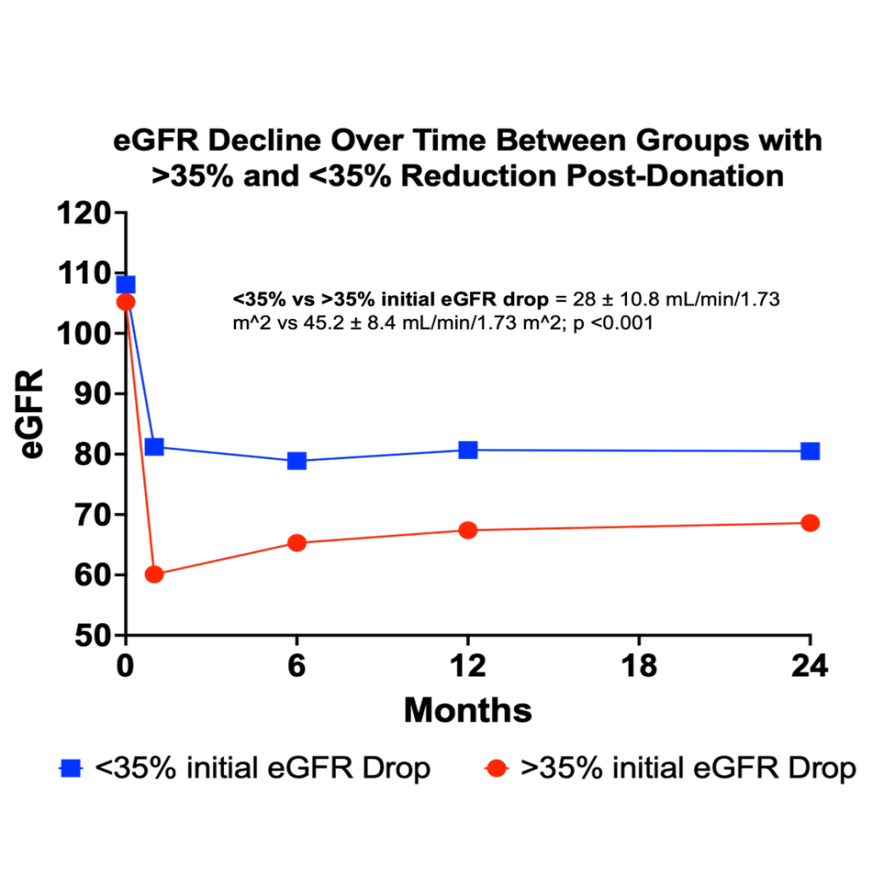Initial eGFR reduction as a predictor of kidney function following living kidney donation: A retrospective analysis
Franco Cabeza Rivera1, Daniel Del Castillo Rix2, Rojin Esmail3, Adriana Medina3, Veronica Ortigosa Serrano4, Adela Mattiazzi1, Mahmoud Morsi5, Rodrigo Vianna 6, Gaetano Ciancio5, Giselle Guerra1.
1Division of Nephrology and Hypertension, University of Miami Miller School of Medicine, Miami, FL, United States; 2Department of Medicine, University of Miami Miller School of Medicine, Miami, FL, United States; 3Ross University School of Medicine, Bridgetown, Barbados; 4Hospital Beneficent São Carlos, Rio Grande do Sul, Brazil; 5Division of Kidney-Pancreas Transplantation, Department of Surgery, Miami Transplant Institute, University of Miami/Jackson Memorial Hospital, Miami, FL, United States; 6Department of Surgery, Liver and Gastrointestinal Transplantation, Miami Transplant Institute, University of Miami/Jackson Memorial Hospital, Miami, FL, United States
Introduction: Immediately following living kidney donation, kidney function is expected to decrease by 25-40%, followed by a physiological adaptation of compensatory hyperfiltration. Based on pre-donation characteristics, identifying the individuals who will fail in this adaptation and assessing the impact of their initial adaptive response to donation can enhance the selection, counseling, and subsequent care of living kidney donors. We aim to identify potential areas of intervention that could improve the long-term outcomes of living kidney donors.
Methods: This retrospective analysis evaluated data from seven hundred ninety-one living kidney donors at the Miami Transplant Institute between 2011 and 2021. We reviewed demographics, kidney biopsies, kidney function estimated before donation and one, six, twelve, and twenty-four months post-donation. The estimated Glomerular Filtration Rate (eGFR) was calculated using the 2021 CKD-EPI formula. Descriptive statistics and logistic regression models were employed to assess these factors’ impact on changes in eGFR at 12- and 24 months post-donation. Significant declines were defined as reductions exceeding 35% of the pre-donation eGFR value. Statistical significance was determined at a p-value of less than 0.05, with analyses performed using STATA/BE, version 17.
Results: Our cohort comprised seven hundred ninety-one donors and four hundred and ninety-six continued follow-up at 24 months. The study population included 62.8% females, 34% Caucasian, 19.6% African Americans, 43.8% Hispanics, and 2.5% from other racial groups. Mean eGFR ± SD reductions at 12 and 24 months were 33.2 ± 12.8 mL/min/1.73 m^2 and 32.5 ± 12.8 mL/min/1.73 m^2, respectively. No significant association was observed between >35% eGFR decline and evaluated variables: age over 50, gender, race, smoking status, hypertension, BMI >30, kidney biopsy with >10% glomerulosclerosis, or pre-donation eGFR. Nonetheless, initial eGFR decrease greater than 35% in the 2–4-week post-donation phase significantly predicted a persistent decline at 12 and 24 months, with mean drops of 45.2 ± 8.4 mL/min/1.73 m^2 compared to a 28 ± 10.8 mL/min/1.73 m^2 for those with greater than and less than a 35% drop, respectively (Figure 1) (p <0.001).
Conclusion: This study offers insights into living kidney donation’s effect on kidney function in a racially diverse population, highlighting the nonstatistical significance of demographic variables and biopsy glomerulosclerosis as predictive factors. However, significant one-month post-donation eGFR reduction emerges as a critical indicator of long-term kidney function, emphasizing the need for closer post-donation monitoring and care for these patients. Further research into the early implementation of nephroprotective strategies and close follow-up could prevent additional eGFR decline in these living kidney donors.

[1] Living Donation
[2] Living Kidney Donation
[3] Donor Outcome
[4] Predictive Model
[5] Kidney Donation
[6] Donor Cohort
